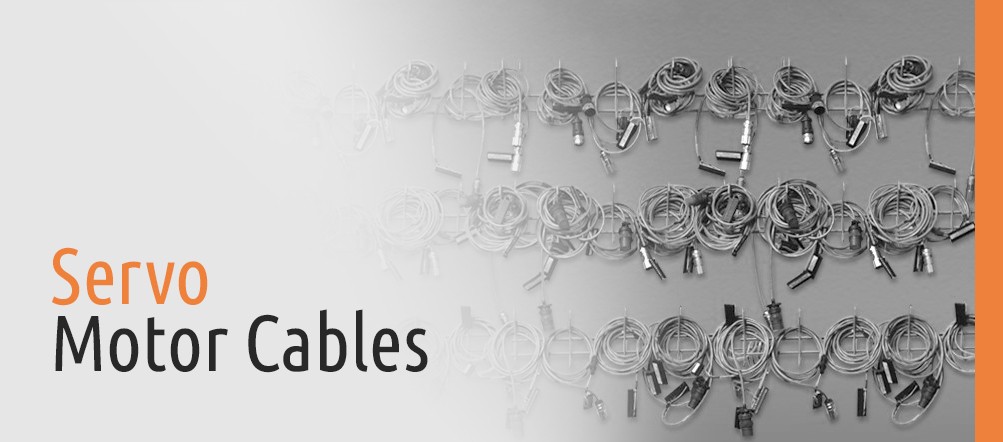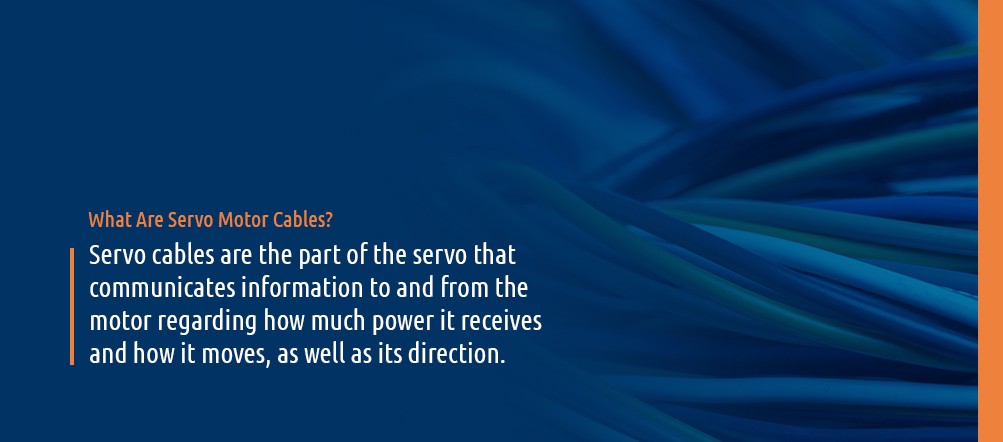Servo Motor Cables
Servo motors might be small, but they are a critical piece of equipment for many projects across a variety of commercial and non-commercial applications. They are ideal for projects that require both high speed and high torque. Different variations of servo motors operate at different rates and in different directions. Each typically functions with 4 to 6 volts.
The three types of servo motors are:
- Linear: These motors have additional built-in gears to change the output from circular movements to back-and-forth movements.
- Continuous rotation: As the name implies, these motors can continuously move in either direction at various speeds.
- Positional rotation: This motor — the most common type — rotates in 180 degree half circle movements.
Each motor is self-contained and relies on the same components to function:
- Motor: Motors have built-in metal or plastic gears and are either AC or DC, depending on how it interprets speed. DC motors are often classified based on whether it has a brushless or brushed design. AC motors are often differentiated based on the rotation speed and whether it is synchronous or asynchronous.
- Potentiometer: This is a type of variable resistor that produces the voltage necessary for speed.
- Controller: This is the control board, which dictates the direction and precise movements the motor makes.
What Are Servo Motor Cables?
Servo motor cables are the part of the servo that communicates information to and from the motor regarding how much power it receives and how it moves, as well as its direction. Both feedback and power servo motor cables come in different shapes, including flat or braided, and you can use them for either continuous or static operations.
But how do servo motor cables function? You will see three different colored wires coming from the motor case when you look at your servo motor. These wires are responsible for the communication and power supply that takes place between your servo motor cables and the device or machine you have connected them to. When connecting your servo motor cables to a device or machine, be sure you are connecting the right wires into the correct ports — or you’ll risk your device working incorrectly or not at all.
Each color represents a different function:
- Brown or black: This is the ground wire, which connects to your device via the ground pin.
- Red: This is the power supply wire that moves the voltage to and from the device that your servo motor is connected to.
- White, yellow or orange: This is the control signal wire, which uses electrical pulses to communicate the direction to the motor.
The best way to keep these wires and your servo motor cables safe is to use a protective jacket and braided or temperature-resistant sleeve to protect them from fraying or breaking. This is especially important if you intend to use your connected device outdoors. Adding a protective shield will also help reduce the amount of electromagnetic interference you could experience in some systems with cross-talking encoder cables.
Three types of cable shielding include:
- Braid shields: These protective sleeves are typically made of copper and are twisted for higher coverage.
- Spiral shields: These shields are more flexible than braid shields and perform well at low frequencies.
- Foil shields: These shields are made of aluminum, and either face outwards or towards the cable conductors or edge.
It’s important to note that cable shields also vary in insulation thickness, so they are suitable for multiple application volumes. Choose servo motor cables that will fit the amount of power you anticipate working with, as well as the required level of flexibility.
Common Applications for Servo Motor Cables
Several types of servo motor cables and servo connector types are available on the market today, and they can be used across various applications. For example, some typical applications include:
- Robotics: In robotics, engineers use servo motors and cables to make specific parts of the robot move and function at the joints. These movements can be broad or precise, depending on the size and quality of the servo motor.
- Tracking and positioning: As telescopes and positioning antennas move, they are operating via servo motor mechanics. The same technology is used in solar panel tracking for green homes and businesses.
- Industry: Several industrial applications operate through the use of servo motor cables, including metal cutting and fabricating, milling machinery and tools, picking equipment and conveyor belts.
- Hobby projects: Whether for personal crafting or commercial sale, servo motor cables are an integral part of model airplanes, woodworking projects and textile production.
- Public places: Elevators and automatic doors utilize servo motors to sense and dictate movement. Vehicles use them to help regulate speed based on the amount of pressure applied to the pedals.
- Household objects: Servo motor cables are behind the operation of many items you find around your house or business. When you allow your camera to focus automatically, it’s doing so through servo motor technology. Printers, DVD players, video game disc drives and remote-controlled toys also move for the same reason.
Because servo motors are adaptable and do not take up a lot of space, there are endless possibilities and applications for which they can be used. Some businesses even rely on multiple types of servo motors or hybrid cables to carry out various tasks throughout production.
Servo Motor Cable Repairs and Replacements
As you can see, servo motors and servo motor cables exist in almost every area of our lives, including specific areas of your industry. Understanding what a servo motor cable is and what it is used for is the best way to ensure you’re utilizing the most effective servo motor for your company’s applications.
It is possible for your servo motor cables to become damaged, which could interrupt operations or even break equipment if left unchecked. If you’re having problems with improper voltage or system shorts, Global Electronic Services can inspect and diagnose your device and make the necessary repairs. Consider scheduling routine maintenance and service checks on your system to minimize the risk of servo motor damage.
Request a quote or learn more about our servo maintenance and repair services.


